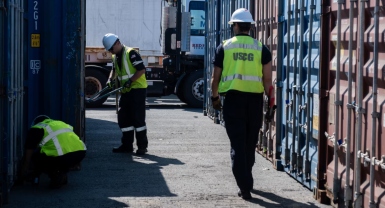
US Coast Guard Sector New York personnel conducted three warehouse spot checks at the Port of New York and New Jersey during the last week of April, uncovering a 60% deficiency rate in hazardous material compliance.
The targeted inspections, driven by Customs and Border Protection (CBP) container screening data, are part of an expanded effort to detect undeclared hazardous cargo before it can pose a threat to port safety or vessel crews. When CBP identifies anomalies or items of interest during targeted container inspections, they now routinely notify Coast Guard Sector New York personnel, who follow up with specialized checks focused on undeclared hazardous materials.
“The road ahead is clear — we’re building on the momentum of Operation Terminus to drive year-round enforcement and collaboration. As CBP sharpens its targeting, we’re standing by to act quickly, ensuring these threats are identified and neutralized before they leave the port,” said Lt. Cmdr. Paul Civita, Coast Guard Sector New York’s deputy Safety and Security Operations chief.
The increase in joint enforcement activity follows the success of Operation Terminus, a five-day multi-agency operation conducted in late February. That effort targeted illicit outbound shipments at terminals in Port Newark, New Jersey, and Brooklyn and led to the seizure of eight undeclared hazardous material containers with $88,000 in shipper violations. Authorities also intercepted 33 stolen vehicles valued at more than $2.4 million that were destined for Western African countries.
By intercepting these shipments, officials prevented potential fires and explosions from a lack of hazardous material compliance including automobiles with connected batteries and full gasoline tanks.
“Identifying and detaining these hazardous shipments and stolen vehicles highlights our dedication to port safety. Knowing my work prevents disasters and stops criminal networks makes every effort worthwhile,” commented Petty Officer 3rd Class Kenadi Kane, a Coast Guard Sector New York marine science technician specializing in container inspections.
Estimating the number of containers carrying dangerous goods is challenging due to mis- and non-declaration. According to Allianz’ Safety and Shipping Review 2024, even as the exact cause of many container ship fires is uncertain, mis-declared hazardous goods, such as chemicals, batteries, and charcoal, are often a contributing factor.

